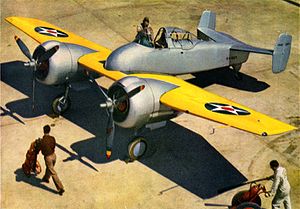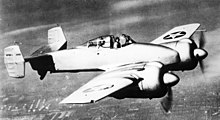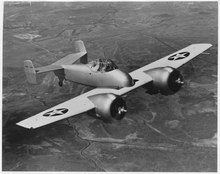Grumman XF5F
| Grumman XF5F Skyrocket | |
|---|---|
 Grumman XF5F in an early version |
|
| Type: | Prototype of a carrier-based fighter aircraft |
| Design country: | |
| Manufacturer: | |
| First flight: |
April 1, 1940 |
| Commissioning: |
Flight tests ended on December 11, 1944 |
| Production time: |
Was never mass-produced |
| Number of pieces: |
1 |
The Grumman XF5F Skyrocket was a twin-engine, ship-based fighter prototype of the US Navy from 1940. What was striking about the aircraft was the very unusual wing configuration.
history
In 1938, Grumman introduced his Model G-34 to the US Navy. It was radically different from the previous single-engine naval fighters, which had just been converted from double-deckers to monoplane . The low - wing G-34 had two radial engines, a double rudder unit and a wing that was moved exceptionally far forward. The nose of the fuselage ended in the middle of the wing.
On June 30, 1938, the US Navy ordered a prototype equipped with two 23 mm Madsen cannons called the XF5F-1 .
The aircraft flew for the first time on April 1, 1940. The flight was accompanied by cooling problems in the engines, which resulted in corresponding modifications.
Further changes resulted in a lower cockpit canopy and a new armament. Four 12.7 mm machine guns were installed. The engine nacelles were rebuilt, the propeller hubs got spinners and finally the fuselage was extended beyond the leading edge of the wing. These changes were completed on July 15, 1941. After several test flights, further changes had to be made, which were completed on January 15, 1942.
In the meantime, Grumman was already working on a successor with more powerful engines, the XF7F-1 . The XF5F-1 has meanwhile been further tested and the results for the XF7F-1 have been taken into account. The tests of the XF5F-1 were characterized by various landing gear problems during landing.
Despite a successful landing on an aircraft carrier on December 11, 1944, the program was discontinued. The development of the XF7F-1 led parallel to the high-performance fighter-bomber Grumman F7F Tigercat , one of the most advanced piston aircraft of the US Navy during World War II .
Grumman XP-50
A further development of the XF5F-1 was the XP-50 (factory designation G-46 ) with two Wright R- 1820-67- / 69 engines. It had an even longer fuselage bow and, unlike the XF-5F-1, a nose wheel landing gear . The first flight took place on February 14, 1941, but on May 14, a turbocharger exploded in flight and the machine crashed into Long Island Sound. The development was then stopped.
Technical specifications
| Parameters | Data |
|---|---|
| length | 8.76 m |
| span | 12.80 m |
| Wing area | 28.2 m² |
| height | 3.45 m |
| drive | 2 × Wright XR-1820-40 / 42 9-cylinder radial engine with 1,200 hp each |
| Top speed | 616 km / h at sea level |
| Range | 1,930 km |
| crew | 1 |
| Service ceiling | 6,160 m |
| Empty mass | 3,677 kg |
| Flight mass | 4,600 kg |
| Armament | four 12.7 mm machine guns, two 75 kg bombs |
literature
- William Green: War Planes of the Second World War - Fighters, Vol 4 . London, UK: MacDonald, 1961. ISBN 0-356-01448-7 .
- William Green, Gordon Swanborough: WW2 Aircraft Fact Files: US Navy and Marine Corps Fighters . London, UK: Macdonald and Jane's, 1976. ISBN 0-356-08222-9 .
- David Lucabaugh, Bob Martin: Grumman XF5F-1 & XP-50 Skyrocket, Naval fighters number thirty-one . Simi Valley, CA: Ginter Books, 1995. ISBN 0-942612-31-0 .
Web links
Individual evidence
- ^ History of the Grumman XP-50. (No longer available online.) In: US Air Force Fact Sheet. National Museum of the United States Air Force , July 27, 2006, archived from the original on October 20, 2012 ; accessed on March 21, 2020 (English): "Written in mid-1941"


